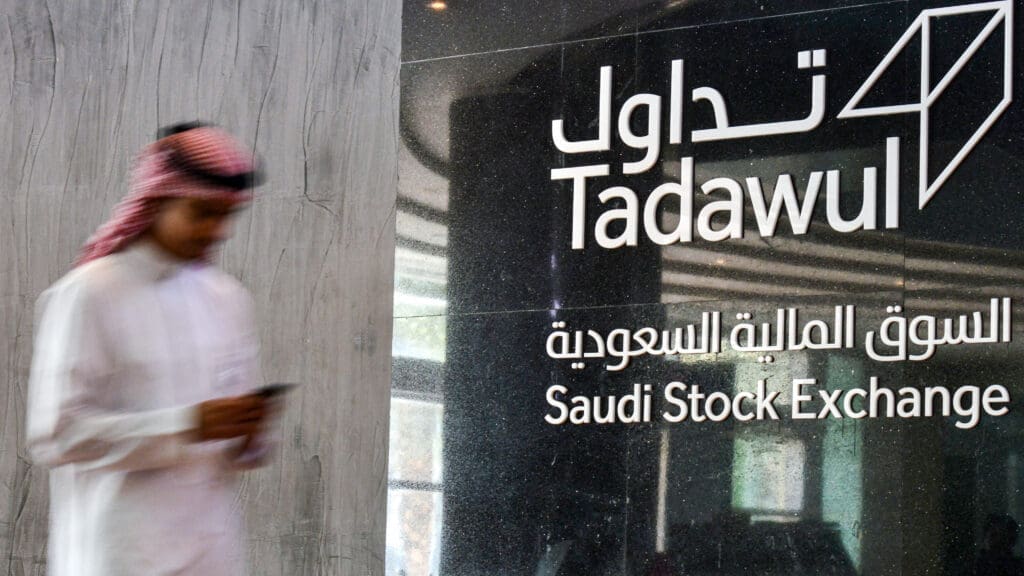When news broke in late September that Saudi Arabia’s stock exchange was considering removing limits on foreign ownership of listed companies by the end of the year, the market surged, helping to erase losses that had made the Tadawul All-Share Index (TASI) one of the world’s lowest-performing stock markets in 2025. Although there have been no notable examples of foreign investors reaching the current cap of 49 percent, the rumored change signals that Saudi Arabia is seeking greater foreign investment to meet its Vision 2030 goals.
This year, the price of a barrel of oil has fallen from a high of around $78 in mid-January to below $60 in mid-October. According to the International Monetary Fund, the Saudi government needs a breakeven price of around $96 per barrel to balance its budget. To achieve its Vision 2030 targets, including capitalizing the Public Investment Fund (PIF, the kingdom’s sovereign wealth fund), that price rises to $111 per barrel.
Raising the cap, combined with additional policy changes and lower global interest rates, could increase capital inflows and help the Saudi government reach its 2030 target of attracting $100 billion in foreign direct investment (FDI).
If the kingdom does indeed lift ownership caps, it will not be alone. In June 2020, the UAE scrapped the requirement that a foreign investor have an Emirati partner when opening a company. Similarly, Qatar began moving to allow 100 percent foreign ownership of businesses in 2019—although both countries exclude strategic industries like security, energy, telecommunications and insurance from full foreign ownership.
Reports that Riyadh will make a similar move reflect its quest to attract more portfolio investment, open its markets and integrate them with the global economy. Foreign investment inflows could help offset budget shortfalls should oil prices remain low.
A Gradual Opening
Riyadh’s latest signals are hardly a surprise, following a string of earlier moves to open the Saudi economy to foreign investment. In 2015, regulators opened the stock market to Qualified Foreign Investors, defined as financial institutions with a minimum $5 billion in assets under management. Since 2016, the country has allowed 100 percent foreign ownership in certain companies, such as in the manufacturing, retail and wholesale sectors. In 2017, the kingdom required companies listed on the TASI to use international reporting standards, which increased transparency via financial audits and aligned the exchange’s systems with global benchmarks.
Since that year, policymakers have reformed corporate governance regulations and listing requirements; created Nomu, a parallel exchange for small and medium enterprises; and allowed non-resident foreigners to subscribe to initial public offerings (IPOs). Saudi regulators have worked with S&P Dow Jones, FTSE and MSCI to include Saudi stocks in their indices. In 2019, the country streamlined business licensing under the “Invest Saudi” scheme.
Saudi Arabia’s economic reforms, aggressive government investment and alignment with global standards has led to billions of dollars in passive inflows. This culminated in the historic IPO of state oil giant Saudi Aramco in 2019, which raised around $25 billion and set a $1.7 trillion valuation. Riyadh used the capital to fund Vision 2030.
Despite these moves, global economic indicators point to subpar growth and lower oil prices ahead, constraining Saudi Arabia’s ability to fund Vision 2030. Geopolitical tensions, such as the Israel-Iran war in June 2025 or attacks by Yemen’s Houthis on vital shipping routes, could create further price volatility and erode fiscal revenues. A fall in oil proceeds has prompted Saudi Arabia to resort to international capital markets to plug a $68 billion budget deficit. This in turn has signaled uncertainty and resulted in poor performance on the TASI, making the exchange an outlier in the region; Kuwait’s energy-dependent exchange has grown by 17 percent since the start of the year, and Dubai’s exchange, which is less dependent on oil, is up 20 percent.
This context provides Saudi Arabia with more reasons to open its markets and attract foreign investment. Such moves would also give it space to continue private-sector job creation for its youthful population and to bring in outside expertise to address skills gaps. Regulatory and economic reforms have already boosted female labor force participation, reduced unemployment and supported private sector job growth. According to Saudi Arabia’s Vice Minister of Communications and Information Technology Eng. Haitham AlOhali between 2017 and 2024 women’s representation in information and communication technology (ICT) rose from seven to 35 percent. To hire new Saudi workers entering the labor market, the country needs to create 920,000 new jobs by 2030. To that end, Vision 2030 aims to create a highly skilled workforce to enter both established fields—like engineering, healthcare or ICT—and emerging fields such as artificial intelligence (AI) and climate technology.
Saudi investment in the latter has lagged due to a regional skills shortage and investor demand for rapid returns. To remedy this, in 2021 the government pledged to invest $187 billion by 2030 to boost job creation in the sector and to target net-zero emissions. So far, Vision 2030 reforms have increased non-oil economic activity to 52 percent of total GDP in 2024, likely to rise to 57 percent this year.
Following the Opportunities
Greater opening of Saudi markets will likely benefit the mining, healthcare, construction and real estate, insurance, ICT and power generation sectors. The Saudi government plans to roll out mandatory government health insurance for all citizens in 2026. Combined with efforts to increase vehicle insurance coverage, this will boost demand for insurance products. Robust demand for residential housing by young working Saudis, combined with Vision 2030-funded infrastructure projects, will continue to drive growth in the construction sector, while housing purchases will also stimulate growth in the mortgage market.
Saudi Arabia has been deploying PIF funding to secure its place in new sectors such as green energy, hydrogen, electric vehicles and AI. To move to 50 percent renewable energy in its electricity mix by 2030, S&P estimates that Saudi Arabia needs to add 90 gigawatts (GW) of renewable energy and 48 gigawatt-hours of storage capacity. The PIF and a consortium of Saudi utilities signed an $8.3 billion agreement in July to develop 15 GW of renewable energy, raising the kingdom’s total contracted renewables production to 43 GW. Saudi Arabia is also funding a green hydrogen project at NEOM—a planned-city megaproject that is a hallmark of Vision 2030.
The Saudi digital infrastructure sector also provides investment opportunities. Saudi Arabia attracted $20 billion in investment to expand data center capacity to 2 GW by 2030, showcased by its DataVolt partnering with Supermicro to build a net-zero AI campus in NEOM.
The Saudi technology sector is already attracting foreign investment. China’s Lenovo is building a computer and server assembly factory in the country. Dell and HP are scouting factory sites as they explore expansion there, while Saudi firm Alat is partnering with Japan’s SoftBank Group to manufacture industrial robots. The kingdom has also been working to attract both China’s Foxconn, which assembles products for Apple, and Taiwan’s Quanta, which makes computers and components for Dell. Saudi Arabia’s mining sector, valued at $2.5 trillion, is another growing sector. Riyadh plans to increase investment in mining activities from $17 billion in 2024 to $75 billion by 2030. Finally, PIF has invested in developing a domestic auto industry, negotiated collaborations with Foxconn and Hyundai, and bought a majority stake in Lucid, a California-based EV company.
Vision 2030 has already diversified the Saudi economy, but the share of non-oil exports in the country’s gross domestic product remains below target in its quest to generate 65 percent of GDP from the non-oil private sector by 2030. Lifting the foreign ownership cap on Saudi companies would signal to foreign investors that Saudi Arabia wants to further open its markets to achieve its economic goals. As the kingdom welcomes more foreign investment and imposes greater fiscal discipline in 2026, the big test for the implementation of Vision 2030 will be how it pivots from state-led economic development to a market-led economy. Attracting foreign investment into Saudi Arabia’s non-oil sectors could play an important role in supporting non-oil economic growth and job creation.


